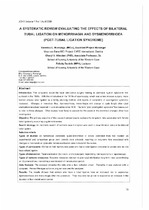| dc.contributor.author | Muntanga, V. L. | |
| dc.contributor.author | Nikodem, Cheryl | |
| dc.contributor.author | Daniels, Felicity M. | |
| dc.date.accessioned | 2017-05-08T11:46:44Z | |
| dc.date.available | 2017-05-08T11:46:44Z | |
| dc.date.issued | 2006 | |
| dc.identifier.citation | Muntanga, V. et al. (2006). A systematic review evaluating the effects of bilateral tubal ligation on menorrhagia and dysmenorrhoea (post-tubal ligation syndrome). Journal of Community and Health Sciences 1(1): 79-90 | en_US |
| dc.identifier.issn | 1990-9403 | |
| dc.identifier.uri | http://hdl.handle.net/10566/2815 | |
| dc.description.abstract | INTRODUCTION: The complaints about the tubal sterilization surgery leading to post-tubal ligation syndrome first surfaced in the 1950s. With the introduction in the 1970s of laparoscopy, which was a less invasive surgery, more women choose tubal ligation as a family planning method, and reports of complaints of tubal-ligation syndrome increased. Changes in menstrual flow, dysmenorrhoea, menorrhagia and change in cycle length after tubal sterilization have been reported in several studies since 1970. The term "post tubal ligation syndrome" has been used to refer to these changes. Often studies have failed to account for the cause in the menstrual changes other than tubal ligation.Objective: The primary objective of this research project was to evaluate the long-term risks associated with female
tubal ligation by executing a systematic review.
SEARCH STRATEGY: An electronic search of available search engines was used to draw literature relevant to bilateral tubal ligation.
SELECTION CRITERIA
TYPES OF STUDIES: All randomized controlled, quasi-randomized or clinical controlled trials that mention an experimental and comparison group (own controls were allowed), reporting on long-term risks associated with changes in the menstrual cycle after female sterilization were included in the review.
TYPES OF PARTICIPANTS: Women in their reproductive years who had a tubal ligation compared to women who did not have a tubal ligation.
TYPES OF INTERVENTION: Tubal sterilization (by macro- or micro-surgery, laparotomy, minilaparotomy or laparoscopy). TYPES OF OUTCOME MEASURES: Outcome measures relevant to post-tubal sterilization long-term risks concentrating on: Dysmenorrhoea, menorrhagia and duration of menstruation period.
DATA ANALYSIS: The reviewer extracted the data unto a data collection sheet. Thereafter it was captured onto a
computer. Review Manager software program was used for analyses.
RESULTS: The results showed that women who have a tubal ligation have an increased risk to experience
dysmenorrhoea and menorrhagia after the procedure. They may also be at risk to experience an increase in the duration of their menstruation period. | en_US |
| dc.language.iso | en | en_US |
| dc.publisher | University of the Western Cape | en_US |
| dc.rights | This journal provides immediate open access to its content on the principle that making research freely available to the public supports a greater global exchange of knowledge. | |
| dc.subject | Tubal sterilization surgery | en_US |
| dc.subject | Laparoscopy | en_US |
| dc.subject | Long-term risks | en_US |
| dc.subject | Bilateral tubal ligation | en_US |
| dc.subject | Post tubal ligation syndrome | en_US |
| dc.title | A systematic review evaluating the effects of bilateral tubal ligation on menorrhagia and dysmenorrhoea (post-tubal ligation syndrome) | en_US |
| dc.type | Article | en_US |
| dc.privacy.showsubmitter | FALSE | |
| dc.status.ispeerreviewed | TRUE | |

